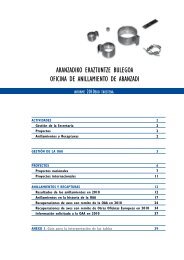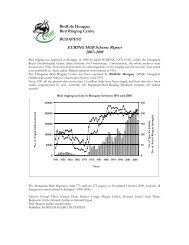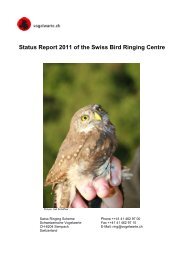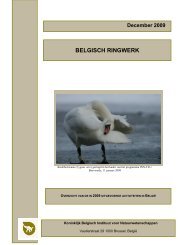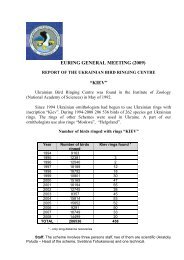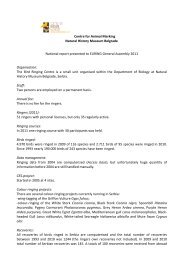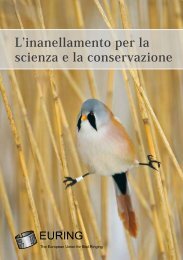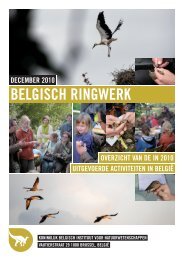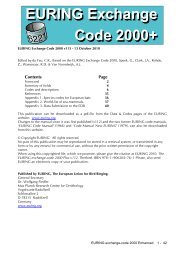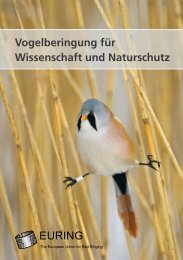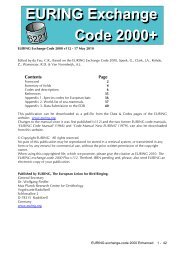The quantitative study of marked individuals in ecology, evolution ...
The quantitative study of marked individuals in ecology, evolution ...
The quantitative study of marked individuals in ecology, evolution ...
Create successful ePaper yourself
Turn your PDF publications into a flip-book with our unique Google optimized e-Paper software.
EURING 2003 Radolfzell<br />
among parameters are preserved. We comb<strong>in</strong>e Bayesian analysis and <strong>in</strong>tegrated<br />
analysis to develop a population dynamics model for the eastern Pacific Ocean (EPO)<br />
spotted dolph<strong>in</strong>. <strong>The</strong> model is developed to <strong>in</strong>clude the various types <strong>of</strong> data that are<br />
available for this population. Informative priors are <strong>in</strong>cluded for several model parameters.<br />
Forward projections are used to <strong>in</strong>vestigate different management options.<br />
04:55 PM - 05:20 PM<br />
Application <strong>of</strong> Bayesian decision mak<strong>in</strong>g and MCMC to the conservation <strong>of</strong> a harvested<br />
species<br />
Chris Fonnesbeck & Mike Conroy<br />
When endeavor<strong>in</strong>g to make <strong>in</strong>formed decisions, conservation biologists must frequently<br />
contend with disparate sources <strong>of</strong> data and compet<strong>in</strong>g hypotheses about the<br />
likely impacts <strong>of</strong> proposed decisions on the resource's status. Frequently, statistical<br />
analyses, model<strong>in</strong>g (e.g., for population projection) and optimization or simulation to<br />
<strong>in</strong>vestigate candidate alternative decisions, are conducted as separate exercises. For<br />
example, a population model might be constructed, whose parameters are then estimated<br />
from data (e.g., r<strong>in</strong>g<strong>in</strong>g studies, population surveys); f<strong>in</strong>ally, the parameterized<br />
model might then be used to <strong>in</strong>vestigate alternative candidate decisions, via simulation,<br />
optimization, or both. This approach, while effective, does not take full advantage<br />
<strong>of</strong> the <strong>in</strong>tegration <strong>of</strong> data and model components for prediction and updat<strong>in</strong>g; we propose<br />
a Bayesian context to provide this <strong>in</strong>tegration.<br />
In the case <strong>of</strong> American black ducks (Anas rubripes) managers are simultaneously<br />
faced with try<strong>in</strong>g to extract a susta<strong>in</strong>able harvest from the species, while ma<strong>in</strong>ta<strong>in</strong><strong>in</strong>g<br />
<strong>in</strong>dividual stocks above acceptable thresholds. <strong>The</strong> problem is complicated by spatial<br />
heterogeneity <strong>in</strong> the growth rates and carry<strong>in</strong>g capacity <strong>of</strong> black ducks stocks, movement<br />
between stocks, regional differences <strong>in</strong> the <strong>in</strong>tensity <strong>of</strong> harvest pressure, and<br />
heterogeneity <strong>in</strong> the degree <strong>of</strong> competition from a close congener, mallards (Anas<br />
platyrynchos) among stocks. We have constructed a population life cycle model that<br />
takes these components <strong>in</strong>to account and simultaneously performs parameter estimation<br />
and population prediction <strong>in</strong> a Bayesian framework. R<strong>in</strong>g<strong>in</strong>g data are used to<br />
develop posterior predictive distributions for harvest mortality rates, given as <strong>in</strong>put<br />
decisions about harvest regulations. Population surveys <strong>of</strong> black ducks and mallards<br />
are used to obta<strong>in</strong> stock-specific estimates <strong>of</strong> population size for both species, for <strong>in</strong>puts<br />
<strong>in</strong>to the population life-cycle model. <strong>The</strong>se estimates are comb<strong>in</strong>ed with the posterior<br />
distributions for harvest mortality, to obta<strong>in</strong> posterior predictive distributions <strong>of</strong><br />
future population status for candidate sets <strong>of</strong> regional harvest regulations, under alternative<br />
biological hypotheses for black duck population dynamics. <strong>The</strong>se distributions<br />
are then used both for the exploration <strong>of</strong> optimal harvest policies and for sequential<br />
updat<strong>in</strong>g <strong>of</strong> model posteriors, via comparison <strong>of</strong> predictive distributions to future<br />
survey estimates <strong>of</strong> stock-specific abundance. Our approach illustrates advantages <strong>of</strong><br />
MCMC for <strong>in</strong>tegrat<strong>in</strong>g disparate data sources <strong>in</strong>to a common predictive framework, for<br />
use <strong>in</strong> conservation decision mak<strong>in</strong>g.<br />
05:20 PM - 05:45 PM<br />
Decision models for the optimal management <strong>of</strong> biodiversity trust fund<br />
Mart<strong>in</strong> Drechler & Frank Wätzold<br />
<strong>The</strong> conservation <strong>of</strong> species generally requires long-last<strong>in</strong>g commitments over many<br />
years or decades. Even though technically, management plans can be designed for<br />
such long timeframes their practical implementation is constra<strong>in</strong>ed by the future<br />
25



